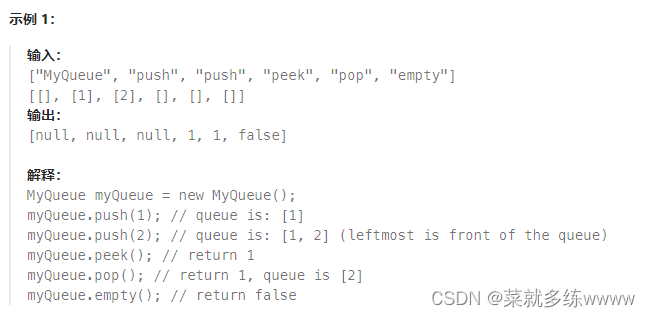232. 用栈实现队列
请你仅使用两个栈实现先入先出队列。队列应当支持一般队列支持的所有操作(
push、pop、peek、empty):实现
MyQueue类:
void push(int x)将元素 x 推到队列的末尾int pop()从队列的开头移除并返回元素int peek()返回队列开头的元素boolean empty()如果队列为空,返回true;否则,返回false

代码示例:
class MyQueue {
public:
stack<int> stIn;
stack<int> stOut;
/** Initialize your data structure here. */
MyQueue() {
}
/** Push element x to the back of queue. */
void push(int x) {
stIn.push(x);
}
/** Removes the element from in front of queue and returns that element. */
int pop() {
// 只有当stOut为空的时候,再从stIn里导入数据(导入stIn全部数据)
if (stOut.empty()) {
// 从stIn导入数据直到stIn为空
while(!stIn.empty()) {
stOut.push(stIn.top());
stIn.pop();
}
}
int result = stOut.top();
stOut.pop();
return result;
}
/** Get the front element. */
int peek() {
int res = this->pop(); // 直接使用已有的pop函数
stOut.push(res); // 因为pop函数弹出了元素res,所以再添加回去
return res;
}
/** Returns whether the queue is empty. */
bool empty() {
return stIn.empty() && stOut.empty();
}
};复杂度分析:
- 时间复杂度:push和empty为O(1), pop和peek为O(n)
- 空间复杂度:O(n)
225. 用队列实现栈
请你仅使用两个队列实现一个后入先出(LIFO)的栈,并支持普通栈的全部四种操作(
push、top、pop和empty)。实现
MyStack类:
void push(int x)将元素 x 压入栈顶。int pop()移除并返回栈顶元素。int top()返回栈顶元素。boolean empty()如果栈是空的,返回true;否则,返回false。

class MyStack {
public:
queue<int> que;
/** Initialize your data structure here. */
MyStack() {
}
/** Push element x onto stack. */
void push(int x) {
que.push(x);
}
/** Removes the element on top of the stack and returns that element. */
int pop() {
int size = que.size();
size--;
while (size--) { // 将队列头部的元素(除了最后一个元素外) 重新添加到队列尾部
que.push(que.front());
que.pop();
}
int result = que.front(); // 此时弹出的元素顺序就是栈的顺序了
que.pop();
return result;
}
/** Get the top element. */
int top() {
return que.back();
}
/** Returns whether the stack is empty. */
bool empty() {
return que.empty();
}
};复杂度分析:
- 时间复杂度:pop为O(n),其他为O(1)
- 空间复杂度:O(n)
20. 有效的括号
给定一个只包括
'(',')','{','}','[',']'的字符串s,判断字符串是否有效。有效字符串需满足:
- 左括号必须用相同类型的右括号闭合。
- 左括号必须以正确的顺序闭合。
- 每个右括号都有一个对应的相同类型的左括号。

代码示例:
class Solution {
public:
bool isValid(string s) {
if (s.size() % 2 != 0) return false; // 如果s的长度为奇数,一定不符合要求
stack<char> st;
for (int i = 0; i < s.size(); i++) {
if (s[i] == '(') st.push(')');
else if (s[i] == '{') st.push('}');
else if (s[i] == '[') st.push(']');
// 第三种情况:遍历字符串匹配的过程中,栈已经为空了,没有匹配的字符了,说明右括号没有找到对应的左括号 return false
// 第二种情况:遍历字符串匹配的过程中,发现栈里没有我们要匹配的字符。所以return false
else if (st.empty() || st.top() != s[i]) return false;
else st.pop(); // st.top() 与 s[i]相等,栈弹出元素
}
// 第一种情况:此时我们已经遍历完了字符串,但是栈不为空,说明有相应的左括号没有右括号来匹配,所以return false,否则就return true
return st.empty();
}
};
复杂度分析:
- 时间复杂度:O(n)
- 空间复杂度:O(n)
1047. 删除字符串中所有相邻重复项
给出由小写字母组成的字符串
S,重复项删除操作会选择两个相邻且相同的字母,并删除它们。在 S 上反复执行重复项删除操作,直到无法继续删除。
在完成所有重复项删除操作后返回最终的字符串。答案保证唯一。
 代码示例:
代码示例:
法一:使用栈来存放
class Solution {
public:
string removeDuplicates(string S) {
stack<char> st;
for (char s : S) {
if (st.empty() || s != st.top()) {
st.push(s);
} else {
st.pop(); // s 与 st.top()相等的情况
}
}
string result = "";
while (!st.empty()) { // 将栈中元素放到result字符串汇总
result += st.top();
st.pop();
}
reverse (result.begin(), result.end()); // 此时字符串需要反转一下
return result;
}
};法二:拿字符串直接作为栈
class Solution {
public:
string removeDuplicates(string S) {
string result;
for(char s : S) {
if(result.empty() || result.back() != s) {
result.push_back(s);
}
else {
result.pop_back();
}
}
return result;
}
};复杂度分析:
- 时间复杂度:O(n)
- 空间复杂度:O(n)
150. 逆波兰表达式
给你一个字符串数组
tokens,表示一个根据 逆波兰表示法 表示的算术表达式。请你计算该表达式。返回一个表示表达式值的整数。
注意:
- 有效的算符为
'+'、'-'、'*'和'/'。- 每个操作数(运算对象)都可以是一个整数或者另一个表达式。
- 两个整数之间的除法总是 向零截断 。
- 表达式中不含除零运算。
- 输入是一个根据逆波兰表示法表示的算术表达式。
- 答案及所有中间计算结果可以用 32 位 整数表示。

代码示例:
class Solution {
public:
int evalRPN(vector<string>& tokens) {
// 力扣修改了后台测试数据,需要用longlong
stack<long long> st;
for (int i = 0; i < tokens.size(); i++) {
if (tokens[i] == "+" || tokens[i] == "-" || tokens[i] == "*" || tokens[i] == "/") {
long long num1 = st.top();
st.pop();
long long num2 = st.top();
st.pop();
if (tokens[i] == "+") st.push(num2 + num1);
if (tokens[i] == "-") st.push(num2 - num1);
if (tokens[i] == "*") st.push(num2 * num1);
if (tokens[i] == "/") st.push(num2 / num1);
} else {
st.push(stoll(tokens[i]));//将其转换为 long long 类型并压入栈中
}
}
int result = st.top();
st.pop(); // 把栈里最后一个元素弹出(其实不弹出也没事)
return result;
}
};复杂度分析:
- 时间复杂度:O(n)
- 空间复杂度:O(n)
补充:
转换函数列表:
stoi:将字符串转换为int。stol:将字符串转换为long。stoll:将字符串转换为long long。stoul:将字符串转换为unsigned long。stoull:将字符串转换为unsigned long long。stof:将字符串转换为float。stod:将字符串转换为double。stold:将字符串转换为long double。
347. 前K个高频元素
给你一个整数数组
nums和一个整数k,请你返回其中出现频率前k高的元素。你可以按 任意顺序 返回答案。

代码示例:
class Solution {
public:
// 小顶堆
class mycomparison {
public:
bool operator()(const pair<int, int>& lhs, const pair<int, int>& rhs) {
return lhs.second > rhs.second;
}
};
vector<int> topKFrequent(vector<int>& nums, int k) {
// 要统计元素出现频率
unordered_map<int, int> map; // map<nums[i],对应出现的次数>
for (int i = 0; i < nums.size(); i++) {
map[nums[i]]++;
}
// 对频率排序
// 定义一个小顶堆,大小为k
priority_queue<pair<int, int>, vector<pair<int, int>>, mycomparison> pri_que;
// 用固定大小为k的小顶堆,扫面所有频率的数值
for (unordered_map<int, int>::iterator it = map.begin(); it != map.end(); it++) {
pri_que.push(*it);
if (pri_que.size() > k) { // 如果堆的大小大于了K,则队列弹出,保证堆的大小一直为k
pri_que.pop();
}
}
// 找出前K个高频元素,因为小顶堆先弹出的是最小的,所以倒序来输出到数组
vector<int> result(k);
for (int i = k - 1; i >= 0; i--) {
result[i] = pri_que.top().first;
pri_que.pop();
}
return result;
}
};复杂度分析:
- 时间复杂度:O(nlogk)
- 空间复杂度:O(n)
补充:
堆特性:
- 优先队列:基于堆的数据结构,通常分为最大堆(max-heap)和最小堆(min-heap)。
- 最大堆:父节点的值总是大于或等于其子节点的值。
- 最小堆:父节点的值总是小于或等于其子节点的值。
区别总结:

参考如下:

























 278
278











 被折叠的 条评论
为什么被折叠?
被折叠的 条评论
为什么被折叠?








